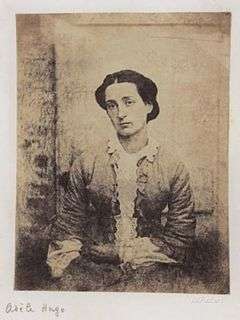Adèle Hugo
| Adèle Hugo | |
|---|---|
|
Adèle Hugo | |
| Born |
28 July 1830 Paris, France |
| Died |
21 April 1915 (aged 84) Suresnes, France |
| Parent(s) |
Victor Hugo Adèle Foucher |
Adèle Hugo (28 July 1830 – 21 April 1915) was the fifth and youngest child of French writer Victor Hugo. She is remembered for developing schizophrenia as a young woman, which led to a romantic obsession with a British military officer who rejected her. Her story has been retold in film and books, such as The Story of Adele H.
Childhood
Adèle Hugo was raised in a cultured, affluent home in Paris, the youngest child of Adèle (née Foucher) and Victor Hugo, France's most famous writer. Adèle enjoyed playing the piano, and was known for her beauty and long dark hair. She sat for portraits by several well-known Parisian artists. In 1851, the Hugo family moved to the island of Jersey, after Victor Hugo was forced into political exile. The family remained on the Channel Islands until 1870. It was in Jersey that Adèle met Albert Pinson, the object of her obsession.
Illness and pursuit of Albert Pinson
Signs of mental illness became apparent in Adèle in 1856. Adèle became romantically involved with a British army officer, Albert Pinson. Pinson proposed marriage to Adèle in 1855, but she rejected the proposal.[1] Adèle had a change of heart, wanting to reconcile with Pinson, but he refused to be involved any further with Adèle. Pinson continued his military career, being sent to the Sixteenth Foot Regiment in Bedfordshire in 1856, where he seldom saw Adèle. Pinson then went to Ireland in 1858, upon promotion to lieutenant, where he was stationed until 1861.[2]
Despite Pinson's rejection, she continued pursuing him. Pinson developed a reputation for living a "life of debauchery".[1] Adèle followed him when he was stationed to Halifax, Nova Scotia, Canada in 1863. Adèle's family worried for her well-being, and tried to track her whereabouts by letters:
Contemporary reports, given by those who may have had some contact with Adèle or who knew her personally, came from her lawyers Mr. Motton and Mr. Lenoir, her neighbors, the local sheriff, and the owner of a bookstore from whom she purchased writing supplies (Guille 132). It is from the document provided by the families with whom Adèle lived, the Saunders and the Mottons, that we have the greatest detail concerning her life during this three-year period. Mrs. Saunders's faithful correspondence with François-Victor in particular, permitted the Hugo family to be kept abreast of Adèle's health, her activities, and her visitors. Their correspondence spans not only the time during which Adèle was a lodger in the Saunders home, but also the time leading up to her departure from Halifax in December of 1866 when she resided with the Motton family two miles outside of town (Guille 100).[3]
In 1866, Pinson was stationed to Barbados, the British colonial centre in the Caribbean region. He completely abandoned Adèle when he left Barbados in 1869; Adèle did not find her way back to France until 1872, and in the interim, the Hugo family was unable to track her activities.
The mystery of Adèle's life in Barbados may have been revealed in an anonymous letter to the editor—signed only "P"—published in the New-York Tribune on 27 May 1885.[2] The head of the Catholic mission in Trinidad, Cathonoy, gave a similar account of Adèle's wretched situation in Barbados in a letter dated 8 September 1885. He relates an incident where he met a Barbadian woman of African descent, named Madame Céline Alvarez Baa, who requested that a mass be said for Victor Hugo after news of the author's death. Curious to know the reason for Madame Baa's interest in Victor Hugo, Cathonoy asked questions, and learned that Madame Baa had given Adèle shelter when she was abandoned on Barbados, where she was known as "Madame Pinson". Adèle had been found wandering the streets, talking to herself, detached from her surroundings. Madame Baa took the initiative to take Adèle to her family in Paris. Adèle was then left in medical care. A grateful Victor Hugo reimbursed Madame Baa for her expenses.[1]
Erotomania
Adèle's obsession was a manifestation of erotomania. Along with her other symptoms of mental illness, including hallucinations, Adèle's condition indicates schizophrenia. The illness appeared in other members of the Hugo family; Victor Hugo's brother Eugène was also schizophrenic.[4] She was ultimately sent to live in a mental institution for the affluent outside Paris. She remained there until her death. Out of Victor Hugo's five children, Adele was the only one who outlived him.
Much of what is known about Adèle's life and her pursuit of Pinson comes from her diaries and letters. Adèle kept a journal while she lived on Jersey and Guernsey, which she titled Journal de l'Exil (Diary of the Exile).[4] She stopped keeping a diary by the time she landed in Barbados, due to her mental deterioration.
Adele's story retold
Adele's obsession with Pinson inspired the 1975 biographical film The Story of Adele H., directed by François Truffaut and starring Isabelle Adjani. Several biographies have been published about Adèle Hugo. Also her life and obsession with Pinson was put in a book with the title: Adèle Hugo: La Misérable Paperback – 1993, by Leslie Smith Dow.
See also
References
| Wikimedia Commons has media related to Adèle Hugo. |
- 1 2 3 Cudjoe, Selwyn Reginald (2003). Beyond Boundaries: The Intellectual Tradition of Trinidad and Tobago in the Nineteenth Century. University of Massachusetts Press. pp. 312–14. ISBN 9781558493919.
- 1 2 Carl Sandburg Collections (University of Illinois at Urbana-Champaign Library) (1977). Horizon: 38, 40.
- ↑ Eldrige, Alana (2003). "Adele Hugo: A Bibliographical Note". Nineteenth-Century French Studies. 32.
- 1 2 Frey, John Andrew (1999). A Victor Hugo Encyclopedia. Greenwood Publishing Group. pp. 129–30. ISBN 9780313298967.
